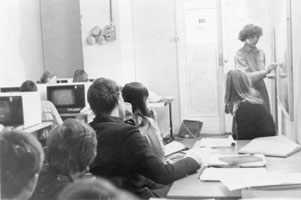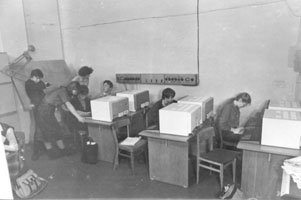Laboratory of Macromolecular Crystallography
This is a review of the works carried out in LMC of the IMPB RAS. Information on other papers in this field
may be found in the original papers listed below.
Teaching of computer science. How it got going.
(N.L.Lunina)
Research Computing Center of the USSR Academy of Sciences engaged in educational
process still before striving for computer competence became nation-wide. In
1981 the municipal administration asked the Institutes of the town to take part
in vocational training of schoolchildren so that they should be able to find
some blue-collar occupation upon leaving school. In the situation of Pushchino
it was somewhat out of place and caused comprehensible problems. It occured to
the administration of the Research Computing Center that in the framework of
that activity they could teach children fundamentals of computer competence.
Thus in 1981/1982 they started familiarizing senior schoolchildren from
Pushchino Experimental Secondary School with the basic principles of working
with computers.


Underlying for the course were the ideas of Prof. A.G. Kushnirenko that such
teaching should be arranged as communication with some "performer" which
understands a system of commands. (Note, that for that time the approach looked
rather non-typical). Huge amount of work was done to adapt these ideas to school
education. In Pushchino schools there were no computers. First groups worked on
ES-1040 with punch cards. Some programs were devised to realize different
"performers" - "graver of the metal", "draftsman", "robot with built-in
calculator", "editor of a word", "foot-passenger", etc. A library of punch cards
with basic operators for these "performers" was created. Students composed their
programs of basic operators of the type of "make one step", "turn left", "car is
on the left". As soon as computer monitors came into practice of the Research
Computing Center they began to be used for school education. Though, monitors
were in short supply and the lessons were arranged on weekends to avoid a
conflict of interests with researchers.
As soon as a computer class bases on SM4 was arranged in the Institute building
sessions 'migrated' there (1984/85school year). The course started with teaching
the computer language MINI which was especially created in the Moscow State
University for educational purposes. Then followed algorithmic languages Pascal
and Fortran. During summer holidays students had practice as operators of large
computers. They were computers ES 1020, ES 1040, ES 1060, ES 1055.
Recall a pair of funny stories that demonstrate great popularity of computer
activity among Pushchino teenagers. It should be noted that tourist club
"Azimuth" was also extremely popular. One day a member of the club complained to
V.Yu.Lunin: "Earlier teenagers used to draw round us and now they spend all
their evenings in the RCC. Who is the woman that entices them from us?" Lunun
had to confess that she was his wife. It is fair to say that the children did
not desert "Azimuth" at all. They were quite active and diversified. When a
student of 1984/87 school year Sasha Golev broke his hand in a field trip he
nevertheless did not cease to attend his computer classes and when he had to
press two buttons on the opposite ends of the keyboard, he pressed one of them
with his nose.
When a computer class based on "Yamaha" was mounted in the Experimental School,
the sessions were arranged partly with "Yamaha", partly with SM-4. In different
years the courses were taught by V.V.Levitin, M.A.Isaev, M.N.Semionenkov,
O.S.Kisljuk, N.L.Lunina. E.E. Schnol used to be an indefatigable consultant of
the work.
In the course of the teaching some manuals were developed in the Research
Computing Center - "The teaching to programming in the secondary school",
"Facultative Course of Programming: Basic Concepts", "Facultative Course of
Programming: Basic", "Facultative Course of Programming: Pascal". The book on
Basic was especially popular. It was reprinted four times (1987, 1988, 1989,
1992) and was inquired from all over Russia.
Most of our students entered Institutions of Higher Education and took courses
of programming there. At that time I used to hear from them an avowal like this:
" Only now have we understood how well you taught us". It was a great pleasure.
In the ensuing years the striving for "computer competence" became wide and
public. Many researchers of our Institute became involved in various forms of
computer education (from schoolchildren to directors of institutes). A special
structure headed by R.M.Borisyuk was formed. But this is quite different
story...
March, 24, 2003
Publications
The full texts of papers
- Lunina, N.L. (1986). "The teaching to programming in the secondary school".
Lecture notes, NCBI AN SSSR, Pushchino. (In Russian)
- Lunina, N.L. (1987). "Algorithmic language Basic for YAMAHA PC". Lecture
notes, NCBI AN SSSR, Pushchino, Russia. (In Russian)
- Lunina, N.L. (1987). "What can the schoolchildren do?" Computer Sciences
and Education, 6, 72-73. (In Russian)
- Lunina, N.L. (1988). "Algorithmic language Basic for YAMAHA PC". Lecture
notes, NCBI AN SSSR, Pushchino, Russia. (In Russian)
- Lunina, N.L. (1989). "A course of programming. PASCAL". Lecture notes, NCBI
AN SSSR, Pushchino, Russia. (In Russian)
- Lunina, N.L. (1989). "A course of programming. BASIC". Lecture notes, NCBI
RAN SSSR, Pushchino, Russia. (In Russian)
- Lunina, N.L. (1989). "A course of programming. Basic constructions".
Lecture notes, NCBI RAN SSSR, Pushchino, Russia. (In Russian)
- Lunina, N.L. (1990). "Computers in education: the goal and the tool". The
seventh seminar "The problems of computer science and its application in
management, education and scientific researches". Geletchica'88. Proceedings,
Sofia, 167-168 (In Russian)
|



